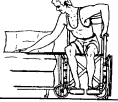
TRANSFERS
Learning how to get in and out of a wheelchair safely and without injury is most important. Transferring to and from your powerchair may require practice and a good sense of balance. It is recommended that whenever possible you have assistance when transferring to and from your powerchair. It is recognised, however, that situations may occur when assistance is not available. It is desirable to learn and practice different techniques to accomplish a safe transfer.
Many experienced wheelchair users have developed and mastered their own method of transferring to and from the chair, resulting in great independence and
To carry out the transfer confidently and to eliminate the possibility of personal injury, check the following:-
•Be sure the power is turned off.
•Be sure that the brakes are on and the drive engaged.
•Tip the footplates up or remove footrest assemblies completely to reduce the risk of leg or foot injury.
•Avoid standing or putting your weight on the footplates. This may cause the chair to tip.
•Remove armrest assemblies completely for side transfers.
Attendant assistance is recommended and the following advice is relevant:-
•The attendant lifting the occupant should take special precautions to avoid tipping or injuries from lifting, supporting, turning and lowering the patient.
•The attendant is responsible for stabilising the wheelchair and must take precautions to prevent the wheelchair moving or sliding during the transfer, ie apply brakes and ensure chair is not in free wheel.
•Be sure that the seat which is being transferred to is stable and will not create a possible hazard by moving or tipping when the occupant is raised or lowered.
If in doubt, ask for assistance or use a device that will ensure safe transfer, ie patient lifter or transfer board.
18